
Bathing your dog at home is not only a great way to keep them clean and healthy but also an excellent opportunity to bond. Regular baths help remove dirt, allergens, and parasites from your dog's coat and skin. Additionally, bathing can help you monitor your dog's health by allowing you to check for any unusual lumps, bumps, or skin issues.
In this guide, we'll provide you with everything you need to know about bathing your dog at home. From preparing for the bath and choosing the right products to step-by-step instructions and post-bath care, we've got you covered.
Table of Contents
Preparing for the Bath
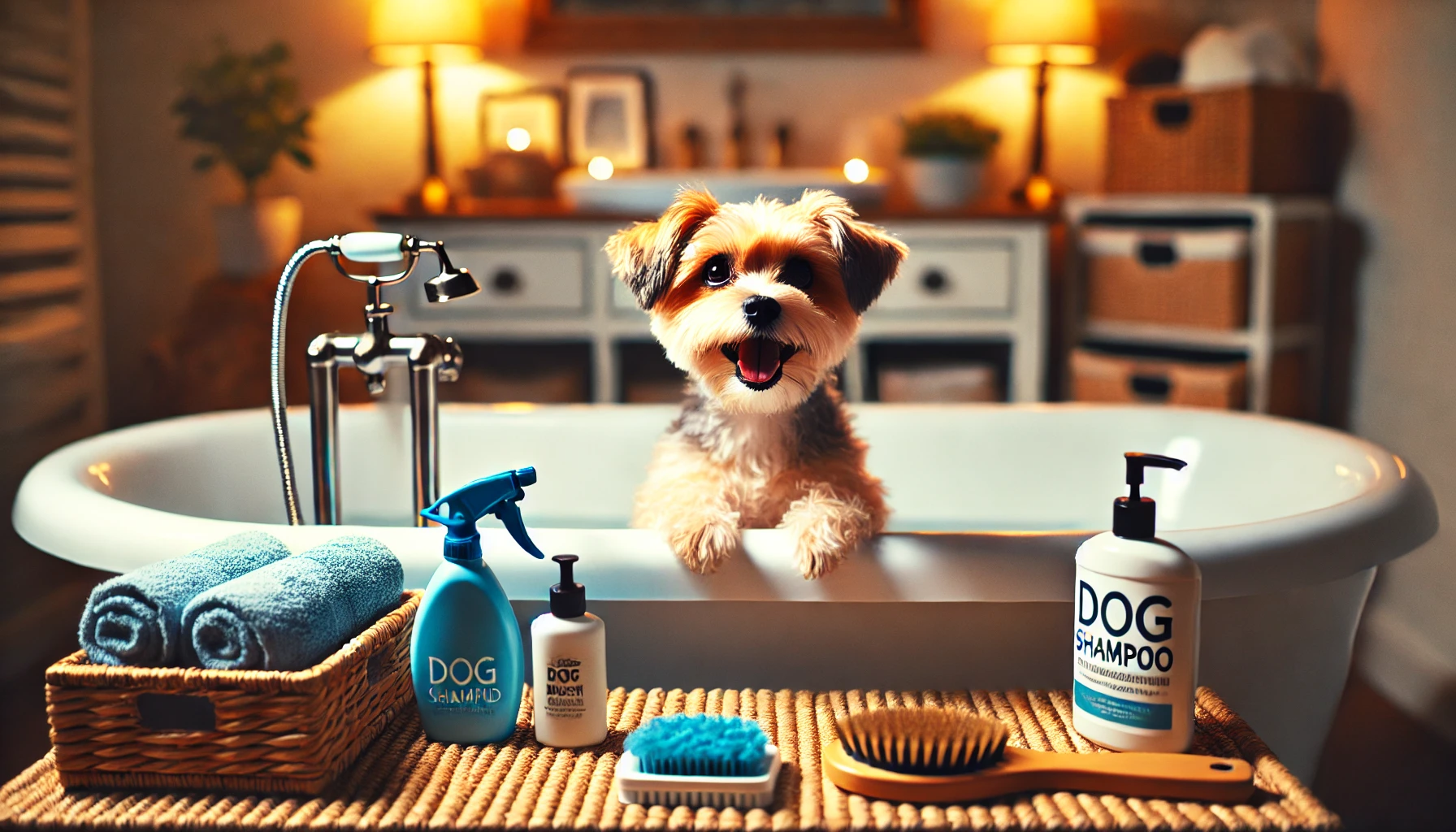
Before you start bathing your dog at home, it's important to prepare properly to ensure the process goes smoothly. Having everything ready beforehand will make the experience less stressful for both you and your dog. Here's how to get started:
Gather Supplies:
- Dog-Specific Shampoo and Conditioner: Choose a shampoo formulated specifically for dogs to avoid skin irritation and maintain the natural oils in their coat. If your dog has a specific skin condition, consult your vet for a recommended product.
- Brushes and Combs: Have a brush or comb suitable for your dog's coat type to remove tangles and loose hair before the bath.
- Towels: Prepare several towels to dry your dog after the bath. You might also want an extra towel to keep yourself dry.
- Non-Slip Mat: A non-slip mat for the bath area can prevent your dog from slipping and help them feel more secure.
- Cup or Shower Head Attachment: Use a cup or a shower head attachment to wet and rinse your dog effectively.
- Treats and Toys: Have some treats and toys on hand to reward and distract your dog during the bath.
Choose the Right Location:
- Size of the Dog: For small dogs, a kitchen sink or a laundry tub might be suitable. Larger dogs may require a bathtub or a walk-in shower.
- Indoor vs. Outdoor: Decide whether to bathe your dog indoors or outdoors. Indoor baths are generally better in cooler weather, while outdoor baths can be more convenient in warmer months.
Pre-Bath Brushing and Preparation:
- Brush Your Dog's Coat: Before the bath, brush your dog's coat thoroughly to remove any loose hair, dirt, and tangles. This makes washing more effective and helps prevent mats from forming when the coat gets wet.
- Check for Mats and Tangles: If your dog has mats or tangles, gently work them out with a comb. Mats can tighten when wet, which makes them harder to remove.
- Trim Nails and Hair (if needed): Trimming your dog's nails before the bath can prevent scratches. If your dog has long hair around their paws or rear end, consider trimming it to make drying easier and more efficient.
Choosing the Right Products
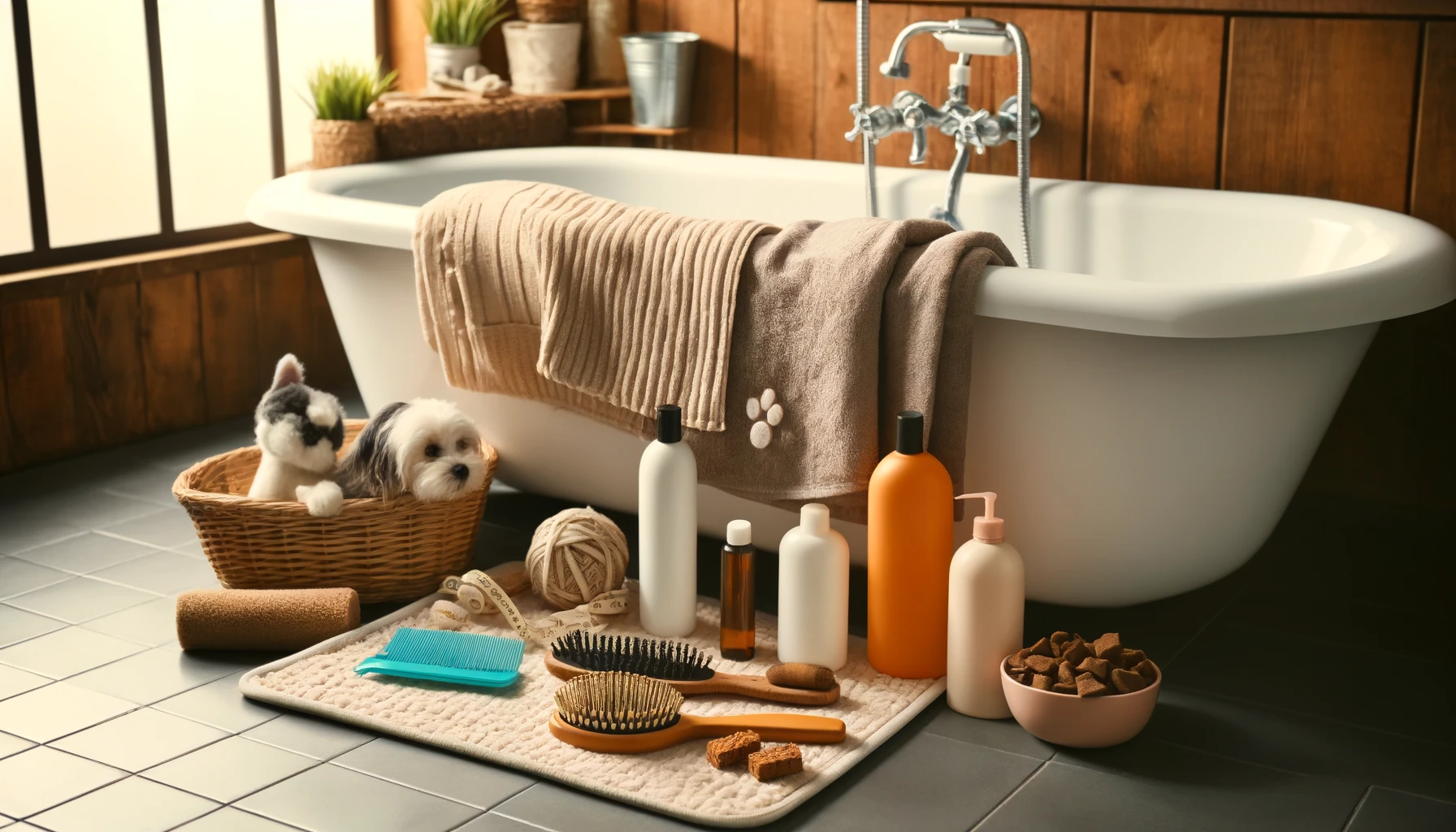
Selecting the right products is crucial for ensuring your dog's bath is effective and safe. Using appropriate shampoos, conditioners, and tools tailored to your dog's needs can enhance their coat's health and shine. Here’s how to choose the best products for bathing your dog at home:
Select Dog-Specific Shampoos and Conditioners:
- Dog Shampoo: Always use a shampoo specifically formulated for dogs. Human shampoos contain ingredients that can be harsh on a dog's skin, leading to dryness and irritation. Look for shampoos that are pH-balanced for dogs and free from artificial fragrances and dyes.
- Conditioner: If your dog has a long or curly coat, consider using a dog conditioner. Conditioners can help detangle fur, reduce matting, and leave the coat soft and shiny. Ensure the conditioner is also dog-specific to avoid any harmful ingredients.
Avoid Harmful Ingredients:
- Natural Ingredients: Opt for shampoos and conditioners with natural ingredients like oatmeal, aloe vera, and coconut oil. These ingredients are gentle on the skin and provide natural moisture and soothing effects.
- Hypoallergenic Options: If your dog has sensitive skin or allergies, choose hypoallergenic products. These are formulated to minimize irritation and are often free from common allergens.
- Medicated Shampoos: For dogs with specific skin conditions, your vet might recommend a medicated shampoo. These shampoos can treat issues like fungal infections, bacterial infections, or severe allergies. Always follow your vet's guidance when using medicated products.
How to Bathe Your Dog
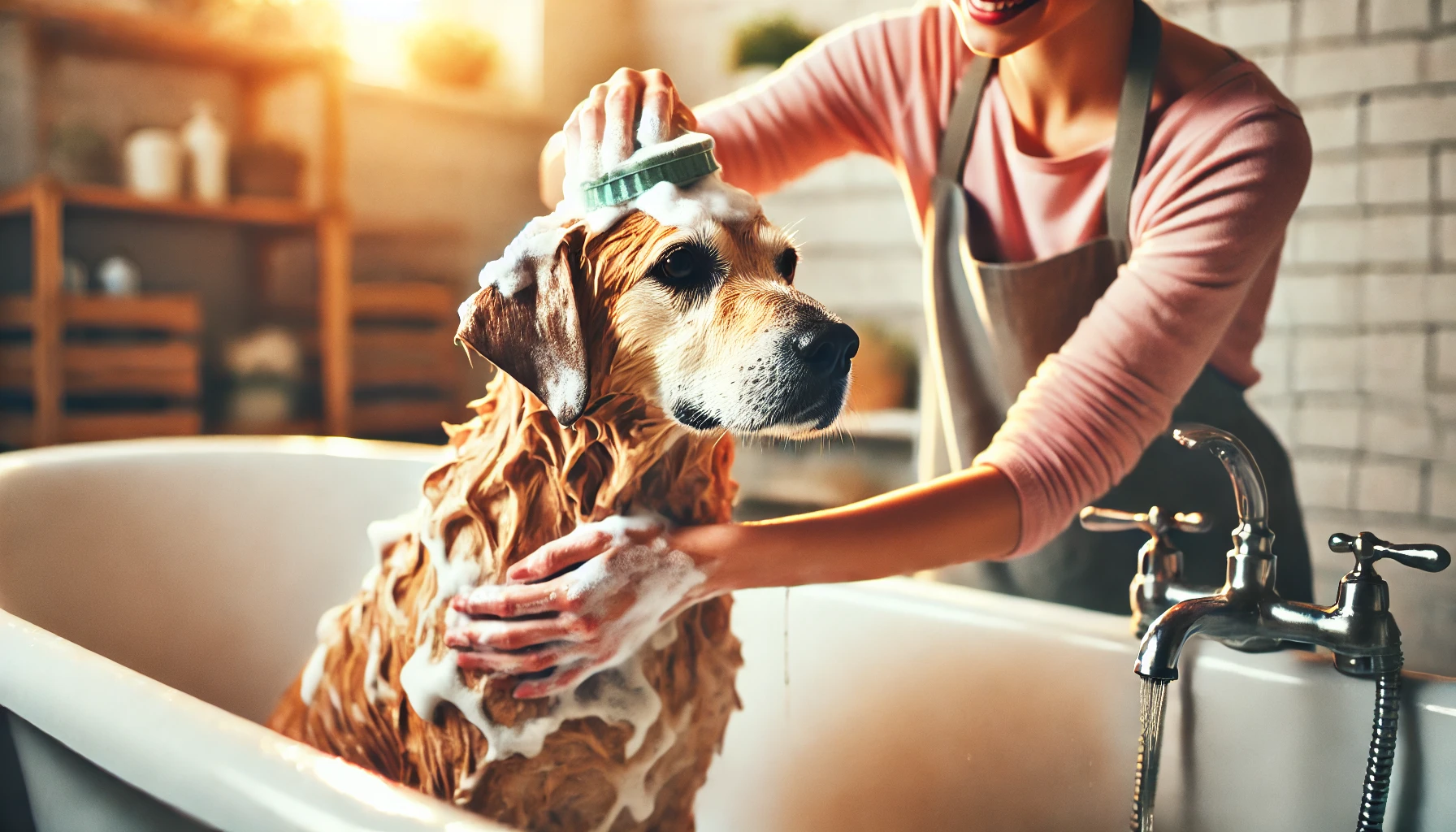
Bathing your dog at home can be a straightforward process if you follow the right steps. Making sure your dog is comfortable and relaxed will make the experience more pleasant for both of you. Here's a step-by-step guide to help you bathe your dog effectively:
Set Up the Bath Area: Before getting started, make sure the bath area is ready. Place a non-slip mat in the tub or sink to prevent slipping. Have all your supplies within reach, including dog shampoo, conditioner, brushes, and towels. Make sure the water temperature is lukewarm, as water that's too hot or too cold can be uncomfortable for your dog.
Wet Your Dog Thoroughly: Gently guide your dog into the bath area and reassure them with a calm voice. Using a shower head attachment or a cup, thoroughly wet your dog's coat. Start from the neck and work your way down to the tail. Be careful to avoid getting water in your dog's ears and eyes, as this can cause discomfort.
Apply and Rinse Shampoo: Apply a small amount of dog shampoo to your hands and lather it into your dog's coat, starting from the neck and moving downwards. Massage the shampoo into their fur, making sure to reach the skin. Pay special attention to areas that tend to get dirty, like the paws, underbelly, and around the rear. Once your dog is thoroughly lathered, rinse off the shampoo completely. Incomplete rinsing can leave residue that might irritate your dog's skin.
Use Conditioner (if needed): If you're using a conditioner, apply it after rinsing off the shampoo. Work the conditioner through your dog's coat. Leave it on for the recommended time specified on the product label, then rinse thoroughly. Just like with shampoo, make sure no conditioner residue is left on your dog's coat to prevent skin irritation.
Final Rinse and Towel Drying: After applying and rinsing the conditioner, give your dog a final rinse to ensure all products are washed out. Once your dog's coat is clean, gently squeeze out excess water with your hands. Use an absorbent towel to dry your dog, starting from the head and moving down to the tail. Pat the fur rather than rub to avoid tangling. If your dog tolerates it, you can also use a pet-safe blow dryer on a low, cool setting to speed up the drying process.
Tips for a Successful Bath
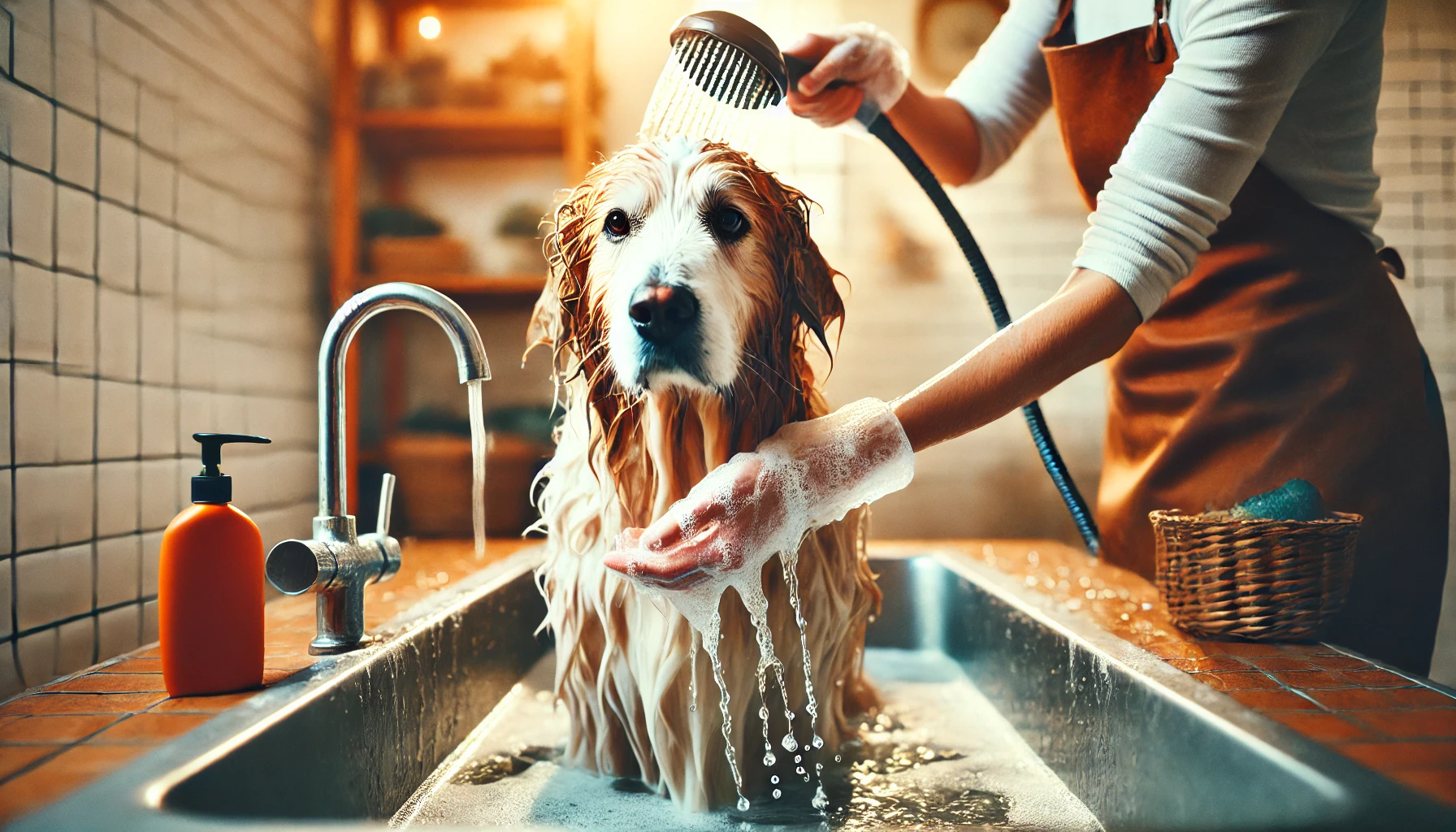
Here are some tips to help ensure a successful bath for both you and your dog:
Keep Your Dog Calm and Comfortable: Creating a calm environment is key to a successful bath. Speak in a soothing tone and use gentle, reassuring touches. If your dog is anxious, try to make bath time a positive experience by offering treats and praise. Playing soft music or using calming sprays can also help relax your dog.
Proper Water Temperature: The water temperature should be lukewarm—neither too hot nor too cold. Test the water with your wrist to ensure it's comfortable. Water that is too hot can burn your dog’s skin, while water that is too cold can cause discomfort and stress.
Handling Special Cases: Puppies, Senior Dogs, and Dogs with Sensitive Skin: Puppies, senior dogs, and those with sensitive skin require special care during baths. For puppies, use a gentle, puppy-specific shampoo and keep the bath brief. Senior dogs might need extra support to stand, so be gentle and patient. For dogs with sensitive skin, opt for hypoallergenic or medicated shampoos as recommended by your vet.
Be Gentle Around Sensitive Areas: When washing your dog, be extra careful around sensitive areas such as the eyes, ears, and nose. Avoid getting water and shampoo in these areas to prevent irritation or infections. Use a damp cloth to clean your dog’s face gently.
Use the Right Technique for Different Coat Types: Different coat types require different techniques. Long-haired dogs may need more thorough brushing before and after the bath to prevent tangles and mats. Short-haired dogs can be bathed and dried more quickly, but still benefit from a good brush to remove loose hair.
Regular Bathing Routine: Establishing a regular bathing routine helps your dog get accustomed to the process. Bathing frequency depends on your dog's breed, coat type, and lifestyle. Generally, dogs should be bathed every 4-6 weeks, but dogs that spend a lot of time outdoors may need more frequent baths.
Reward Your Dog: After the bath, reward your dog with their favorite treat or a fun activity. This helps create a positive association with bath time and encourages good behavior during future baths.
Common Challenges and Solutions

Bathing your dog at home can sometimes come with challenges. Here are some common issues you might face and how to address them effectively:
Dealing with a Resistant Dog: If your dog resists bath time, start by gradually getting them used to the process. Introduce them to the bath area without water and reward them with treats and praise. Gradually add water and continue to reward them for staying calm. Using a non-slip mat can help them feel more secure. Consistency and patience are key—over time, your dog will become more accustomed to baths.
Avoiding Mats and Tangles: Mats and tangles can be problematic, especially for long-haired dogs. Brush your dog's coat thoroughly before the bath to remove any tangles and loose fur. Use a conditioner during the bath to make the fur easier to manage. After the bath, brush your dog again while their coat is still slightly damp to prevent new tangles from forming.
Managing Shedding: Shedding can be a challenge, particularly during the bathing process. Use a de-shedding tool before the bath to remove as much loose fur as possible. A high-quality dog shampoo and conditioner can also help reduce shedding. Regular brushing between baths can keep shedding under control and make the bathing process easier.
Bathing a Large Dog: Bathing a large dog can be more challenging due to their size and strength. Ensure you have a large enough bathing area, such as a walk-in shower or an outdoor space. Use a detachable shower head for easier rinsing and enlist help if needed. Having a second person can make the process smoother by holding the dog or helping with rinsing.
Keeping the Bath Area Clean: Bath time can get messy, especially with a dog that likes to shake off water. Place towels or a waterproof mat around the bath area to catch splashes. After the bath, clean the area thoroughly to remove hair and any leftover shampoo or conditioner. Keeping the bath area clean will make future baths more pleasant and hygienic.
Addressing Anxiety: Some dogs experience anxiety during baths. To help reduce anxiety, create a calm environment with soft music and gentle handling. Using calming sprays or pheromone diffusers can also help. Start with short, positive bath experiences and gradually increase the duration as your dog becomes more comfortable.
Conclusion
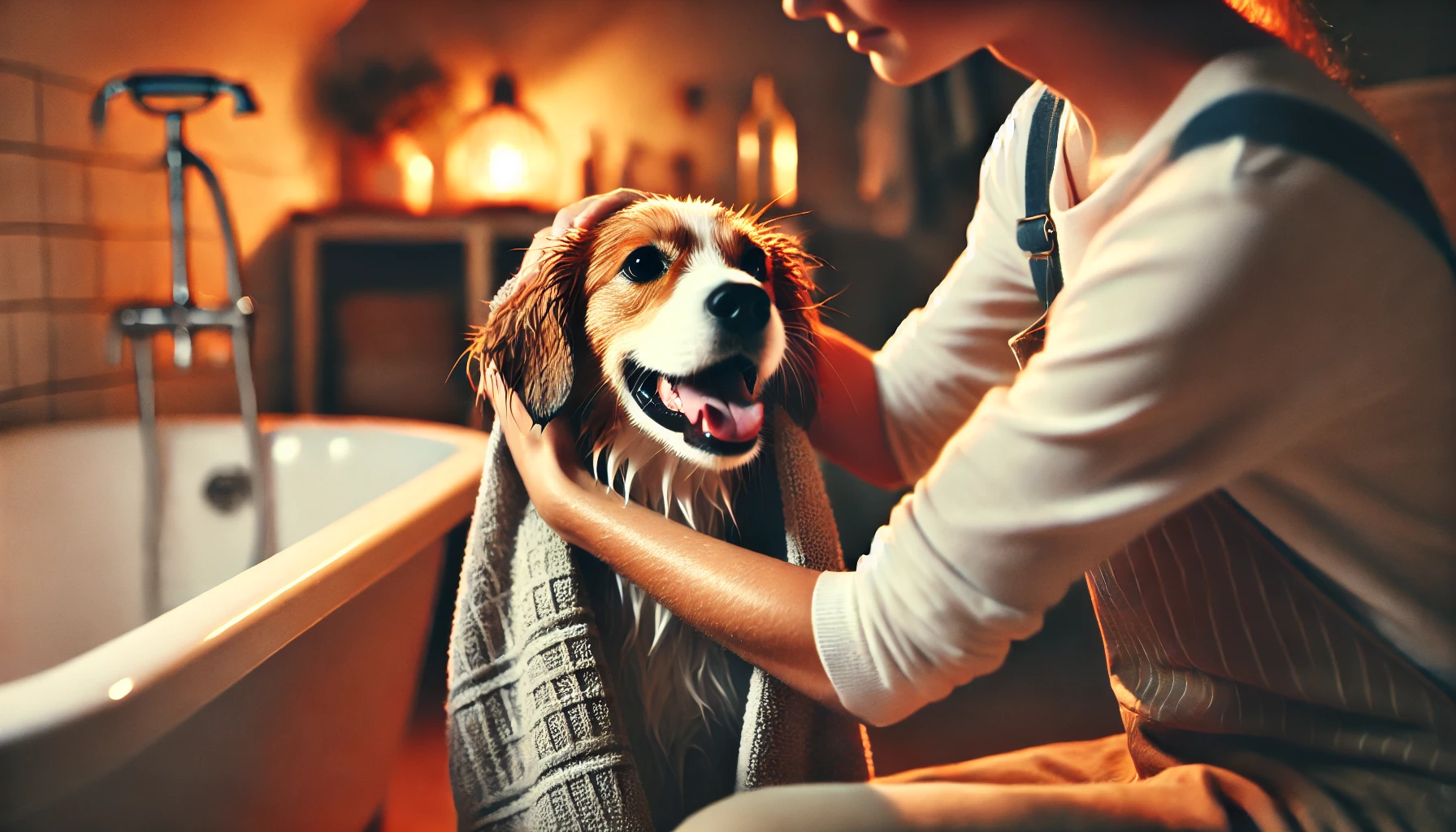
Bathing your dog at home is an essential part of maintaining their hygiene and overall health. By following the steps outlined in this guide, you can ensure that the process is smooth, effective, and enjoyable for both you and your furry friend. Regular baths help keep your dog’s coat clean, reduce shedding, and allow you to check for any potential skin issues.
Other Guides That Might Interest You
Brushing Dog Teeth - A Complete Guide for Beginners
How To Safely Clip Your Dog’s Nails
Puppy Training Guide for New Owners
How to Correct Unwanted Behavior in Dogs
Scroll down to see FAQs about bathing a dog at home
What To Read Next
How To Safely Clip Your Dog’s Nails
How to Brush Your Dog’s Coat
Frequently Asked Questions
What is the best way to wash your dog at home? The best way to wash your dog at home is to start by gathering all necessary supplies, including dog-specific shampoo and conditioner, brushes, towels, and a non-slip mat. Set up a comfortable bathing area with lukewarm water. Thoroughly wet your dog, apply the shampoo, and work it into a lather, focusing on the fur and skin. Rinse completely to remove all shampoo and conditioner. After the bath, dry your dog with towels and a pet-safe blow dryer, and brush their coat to prevent tangles.
How often should dogs be bathed? Dogs should generally be bathed every 4-6 weeks. However, the frequency can vary based on the dog’s breed, coat type, and lifestyle. Dogs that spend a lot of time outdoors or get dirty frequently may need more frequent baths. It’s important not to over-bathe, as this can strip natural oils from their coat.
Can I use human shampoo on my dog? No, you should not use human shampoo on your dog. Human shampoos contain ingredients that can be harsh on a dog’s skin and disrupt the pH balance, leading to irritation and dryness. Always use shampoos formulated specifically for dogs.
Do dogs like warm or cold baths? Dogs generally prefer lukewarm baths. Water that is too hot can burn their skin, while water that is too cold can cause discomfort and stress. Test the water temperature with your wrist to ensure it is comfortable.
Do baths feel good for dogs? Many dogs find baths relaxing, especially if they are used to the process and it is done gently. The warm water and massaging action of lathering can be soothing. However, some dogs may feel anxious or stressed during baths, so it’s important to make the experience as positive as possible.
How to wash a dog's face? To wash your dog’s face, use a damp cloth or a specially designed pet wipe. Avoid using shampoo or getting water directly on their face. Gently wipe around the eyes, ears, and mouth, being careful not to get water or soap in their eyes or ears. This method helps keep your dog’s face clean without causing discomfort.
Should I cover my dog's ears when bathing? Yes, it’s a good idea to protect your dog’s ears from water to prevent infections. You can gently place a cotton ball in each ear (without pushing it in too far) before the bath. After the bath, remove the cotton balls and gently dry the ear flaps with a towel.
Do dogs like being clean after a bath? Many dogs enjoy feeling clean after a bath, as it can be refreshing and soothing. However, some dogs may feel the need to roll around and re-establish their scent. Regardless, clean fur and skin can contribute to their overall comfort and health.
What to use instead of dog shampoo? If you don’t have dog shampoo, you can use a mild, unscented baby shampoo as a temporary substitute. However, it’s best to use products specifically formulated for dogs, as they are designed to meet the unique pH balance and needs of canine skin.
What is the best time to bathe a dog? The best time to bathe a dog is when they are calm and not overly energetic. After a walk or playtime can be a good choice, as they may be more relaxed. Avoid bathing your dog right before bedtime or mealtime. Ensure you have enough time to thoroughly dry and groom them after the bath.



